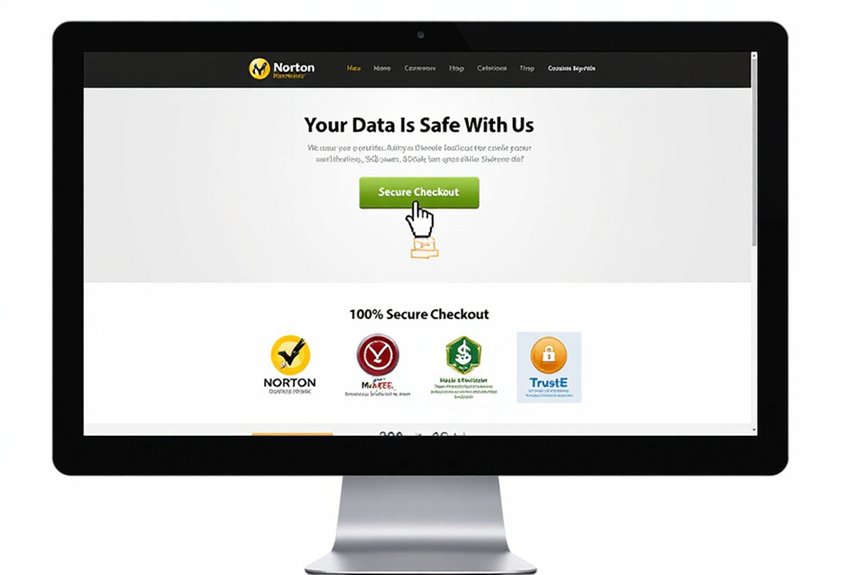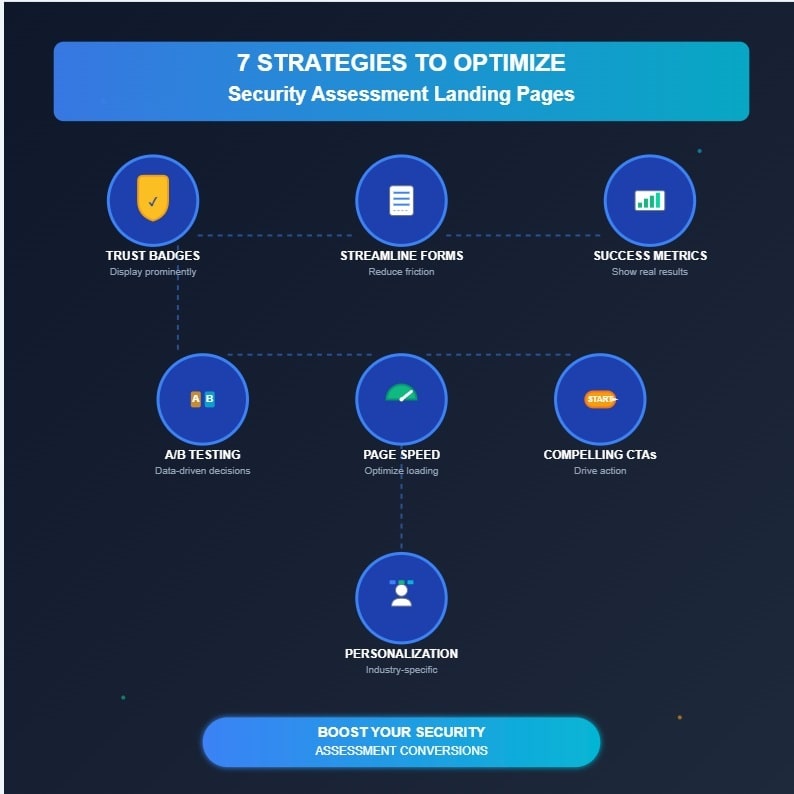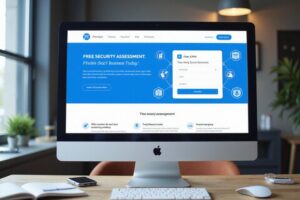Why is it Important to Optimize Security Assessment Landing Pages?
Security assessment landing pages serve as critical conversion points where cybersecurity professionals must balance compliance requirements with user experience optimization. Organizations seeking to increase conversion rates face unique challenges within this specialized niche, as excessive security language may intimidate potential clients while insufficient trust indicators might undermine credibility. The following seven optimization strategies, derived from analysis of high-performing security assessment pages across multiple sectors, address this delicate equilibrium through evidence-based techniques that maintain regulatory compliance while simultaneously enhancing user engagement. What specific industry-specific challenges might require customization of these approaches?
Key Takeaways
- Display security certifications prominently near forms, conversion points, and above the fold to boost trust and conversions.
- Streamline form fields while maintaining compliance to reduce abandonment rates and improve user experience.
- Showcase quantifiable security metrics and client success stories with data visualizations to demonstrate value.
- Implement A/B testing on security-focused elements and optimize page load speed without compromising security features.
- Create urgency through limited-time security assessments and personalize content based on visitor industry or technical proficiency.
Display Security Credentials & Trust Badges Prominently

Security indicators serve as the cornerstone of establishing digital credibility in today’s increasingly skeptical online environment, where users require immediate visual reassurance before engaging with assessment processes.
Organizations must strategically implement badge design that resonates with visitors at critical conversion points, particularly near form submissions and payment gateways, where security concerns peak. In fact, 40.7% of answers from voice search are derived from Featured Snippets, demonstrating the importance of clear and concise messaging.
Effective security messaging, when placed adjacent to calls-to-action, greatly reduces user anxiety while differentiating the organization from competitors lacking visible trust signals.
Strategic placement of security messaging near action points reduces hesitation and elevates your brand above less trustworthy competitors.
Studies by industry researchers like the Baymard Institute demonstrate that implementing trust badges can increase conversion rates by up to 42 percent on e-commerce and service websites.
For best impact, companies should limit displayed credentials to prevent visual fatigue, selecting only current, legitimate badges that reinforce brand reputation and explicitly communicate compliance with recognized industry standards.
Streamline Form Fields While Maintaining Compliance
Nearly 70% of form abandonment issues stem from unnecessarily complex field requirements, highlighting the critical balance organizations must strike between gathering essential information and maintaining regulatory compliance.
When implementing form efficiency strategies, organizations should, first and foremost, identify truly essential data points that satisfy both business requirements and regulatory frameworks such as GDPR and CCPA, thereby eliminating extraneous fields that create friction. A compelling example is how Kommunicate achieved a 25.2% increase in clicks simply by removing a single unnecessary form field.
Additionally, integrating compliance adherence through clearly displayed privacy policies and consent mechanisms serves the dual purpose of building trust while meeting legal obligations, which, when combined with strategic single-column layouts and real-time validation, transforms mandated compliance measures into user experience enhancements.
Showcase Client Success Stories With Specific Security Metrics
Implementing robust form optimization represents only half the equation in effective security assessment landing pages; the compelling presentation of client success stories fortified with specific security metrics offers visitors tangible evidence of real-world implementation efficacy.
Organizations should showcase quantifiable success metrics, such as significant percentage reductions in MTTD and MTTR, alongside comparative industry benchmarks that highlight security program excellence.
When presenting case studies, emphasize risk reduction achievements, vulnerability patching cadence improvements, and implementation of advanced authentication protocols, which, when displayed prominently with supporting data visualizations, transform abstract security concepts into compelling conversion catalysts for hesitant prospects evaluating security assessment services. Incorporating financial metrics that demonstrate clear return on investment from security implementations helps communicate value in terms that business decision-makers immediately understand.
Implement Strategic A/B Testing for Security-Focused Elements

Strategically deploying A/B testing methodologies for security-focused landing page elements enables organizations to make data-driven decisions that greatly enhance visitor conversion rates while maintaining the credibility necessary in the cybersecurity sector.
Through rigorous User Behavior Analysis, security firms can identify which trust signals, such as compliance badges or certification displays, most effectively reduce visitor hesitation during the conversion process.
A/B Testing Strategies should prioritize testing elements sequentially rather than simultaneously, allocating traffic equally between variants for at least 7-14 days to achieve the statistical significance (80%+ confidence) required for accurate result interpretation.
This should be done while carefully documenting outcomes for iterative optimization cycles and focusing on specific elements like headlines, visuals, and CTAs that have demonstrated significant impact on conversion rates in successful campaigns.
Optimize Page Load Speed Without Compromising Security Features
The effectiveness of security assessment landing pages hinges not only on persuasive content and trust signals, but equally on technical performance factors that directly influence visitor engagement and conversion potential.
Implementing strategic page optimization techniques, such as JavaScript minification and deferred loading, while maintaining robust security protocols, creates an ideal balance between performance and protection.
Organizations must leverage CDNs and implement load balancing strategies across distributed servers, thereby reducing latency while ensuring security elements remain intact.
Moreover, compressing images, prioritizing above-the-fold content, and utilizing caching mechanisms can considerably reduce bounce rates without sacrificing essential security features that maintain visitor trust and compliance standards. Research shows that pages taking longer than 3 seconds to load can increase bounce probability by 32% or more, significantly undermining security assessment conversion efforts.
Create Compelling Security-Focused CTAs That Drive Action
Effective cybersecurity call-to-actions, which balance psychological safety with credible security credentials, must establish trust while simultaneously motivating immediate action through strategic placement and design considerations.
Security credentials, such as industry certifications, compliance frameworks, and client testimonials, should be prominently displayed near CTAs to reinforce the organization’s expertise and legitimacy in the security assessment space.
Strategic implementation of urgency tactics, including limited-time security assessment offers or emphasizing the escalating costs of security breaches over time, can considerably increase conversion rates without resorting to fear-mongering that might undermine the professional credibility of the security service provider. Aiming for 10% or above conversion rates should be the benchmark for security assessment landing pages, though this may vary depending on the complexity of services offered.
Create Psychological Safety
Creating psychological safety within security assessment landing pages serves as a fundamental cornerstone for establishing visitor trust, which, when combined with compelling calls-to-action, dramatically increases conversion rates and drives meaningful engagement.
To effectively mitigate visitor anxiety, organizations must implement transparent processes regarding data collection methodologies, while simultaneously incorporating clear, jargon-free messaging that resonates with audiences of varying technical proficiency.
In addition, trust building necessitates the integration of user-friendly navigation pathways that guide visitors intuitively through the assessment process, coupled with readily accessible support options, such as live chat functionality or thorough FAQs, which collectively reduce psychological barriers to conversion. Implementing live chat support on security assessment landing pages can be especially effective since 73% of customers prefer this communication method when seeking assistance.
Show Security Credentials
Demonstrating robust security credentials serves as the cornerstone of establishing visitor confidence in security assessment landing pages, which, when strategically integrated with compelling calls-to-action, greatly enhances conversion potential and customer acquisition metrics. Organizations that prominently display Security Certifications, such as ISO 27001 or SOC 2, create immediate legitimacy, while articulating Compliance Benefits positions services as essential risk-mitigation tools. Personalized CTAs that address specific security concerns convert 202% better than generic security statements.
| Credential Type | Visitor Impact | Implementation Strategy |
|---|---|---|
| Industry Certifications | Builds immediate trust | Place above the fold with recognizable logos |
| Compliance Frameworks | Demonstrates regulatory expertise | Connect to specific industry requirements |
| Security Badges | Provides visual trust signals | Integrate near transaction points |
| Third-Party Validations | Offers social proof | Feature testimonials from security experts |
Use Urgency Tactically
When security vulnerabilities remain unaddressed, organizations face exponentially increasing risks that can transform minor weaknesses into catastrophic breaches. This underscores why strategically implemented urgency tactics on security assessment landing pages serve as powerful conversion catalysts.
Effective urgency messaging strategies include implementing countdown timers for limited-time security assessments, highlighting potential consequences of delayed action, and creating perception of scarcity through limited availability slots.
Moreover, time-sensitive promotions, such as 48-hour assessment discounts or complementary vulnerability scans for immediate sign-ups, greatly increase conversion rates while maintaining professional credibility. This requires careful calibration to avoid appearing manipulative while still conveying genuine time-sensitivity of cybersecurity threats. Security assessment landing pages with optimized call-to-action buttons in contrasting colors can achieve higher conversion rates compared to pages with non-contrasting CTAs.
Leverage Personalization Based on Industry-Specific Security Needs

Organizations seeking to optimize security assessment landing pages must recognize the critical importance of industry-specific personalization, which, when implemented strategically, can dramatically increase conversion rates and engagement.
Through the implementation of industry-specific trust signals, such as compliance certifications relevant to healthcare (HIPAA), finance (PCI DSS), or government (FedRAMP), organizations establish immediate credibility with potential clients who recognize these specialized security frameworks. Prominently displaying visual security cues like padlock icons and “https” in URLs can further reinforce this credibility and significantly reduce perceived user risk.
Segmentation by risk profile, coupled with technically appropriate content that addresses industry-specific vulnerabilities, threat vectors, and regulatory requirements, transforms generic security offerings into tailored solutions that resonate with decision-makers facing unique cybersecurity challenges within their sectors.
Industry-specific Trust Signals
Trust signals within security assessment landing pages must be tailored precisely to address the unique compliance frameworks, regulatory requirements, and security concerns that dominate specific industries, thereby establishing immediate credibility with visitors from those sectors.
The selection of appropriate trust signal types must directly correlate with industry challenges, such as SOC 2 and TrustWave badges for financial institutions, HIPAA compliance indicators for healthcare providers, and secure payment logos for e-commerce platforms.
Meanwhile, technology companies benefit greatly from displaying strategic partnerships with established cloud service providers that reinforce security competence and technological sophistication. A clean, professional design that loads quickly creates an immediate impression of technical reliability and competence when visitors first land on your security assessment page.
Segment by Risk Profile
Three distinct personalization strategies, each targeting specific industry risk profiles, enable security assessment landing pages to deliver tailored content that resonates with visitors’ unique compliance concerns, regulatory landscapes, and threat environments.
Through sophisticated user segmentation techniques, organizations can implement machine learning algorithms that analyze behavioral patterns to categorize visitors according to their security maturity level, thereby presenting relevant solutions that address their specific vulnerabilities. With 94% of companies experiencing increased conversion rates due to website personalization, this approach proves particularly valuable for security firms seeking to maximize engagement.
When organizations leverage AI-driven recommendations based on real-time data analysis, conversion rates typically increase as prospects encounter contextual offers aligned with their risk assessment needs, rather than generic security solutions that fail to acknowledge their industry-specific challenges.
Tailored Technical Content
Building upon the foundation of risk-profile segmentation, tailored technical content represents the intersection where industry-specific security requirements meet personalized user experiences, creating compelling assessment landing pages that speak directly to specialized technical concerns.
To maximize reader engagement and content relevance, security firms should implement:
- Dynamic content modules that automatically adjust complexity levels based on industry vertical and visitor technical proficiency. Leveraging user data from browsing activity can enable security assessment pages to deliver a more relevant experience that addresses specific vulnerabilities related to the prospect’s sector.
- Technical whitepapers and case studies demonstrating sector-specific vulnerability remediation.
- Comparative analysis tools allowing prospects to benchmark their security posture against industry standards.
- Interactive assessment components that incorporate regulatory frameworks relevant to the visitor’s jurisdiction, presenting compliance metrics in context-appropriate technical depth.
Follow Our Suggestions to Optimize Security Assessment Landing Pages
Effective security assessment landing page optimization, through the deliberate implementation of trust signals, streamlined data collection, and personalized content delivery, ultimately transforms visitor hesitation into confident conversion actions. Organizations that methodically apply these evidence-based strategies, while continuously measuring performance against established benchmarks, position themselves advantageously in an increasingly security-conscious marketplace where user trust has become the prerequisite currency for digital conversion success.

Frequently Asked Questions
How Do Privacy Regulations Affect Landing Page Security Requirements?
Privacy regulations mandate robust security protocols, requiring organizations to implement thorough privacy policies and maintain regulatory compliance through encryption, access controls, and transparent data management practices.
What Security Certifications Should Be Prioritized for Different Industries?
Industry specific certifications vary by sector: government requires CompTIA Security+, healthcare prioritizes HIPAA compliance certifications, finance values CRISC, and technology benefits from CEH for vulnerability assessment expertise.
How Frequently Should Security Features Be Updated on Landing Pages?
Security features require monthly content refreshes, quarterly conversion optimization updates, and annual design refreshes. These frequency guidelines guarantee security updates remain relevant to evolving threats and user expectations.
Can Chatbots Enhance Security Perception While Maintaining Compliance Standards?
Chatbots enhance security perception through thoughtful chatbot design that emphasizes protection measures while adhering to compliance standards. This dual approach builds user trust and delivers reassurance through transparent, regulation-compliant interactions.
What Security Metrics Matter Most to Potential Clients Viewing Landing Pages?
Potential clients prioritize data encryption, compliance certifications, and transparent privacy policies as essential security metrics. These elements form the foundation of effective conversion strategies by establishing user trust through demonstrable protection measures.


